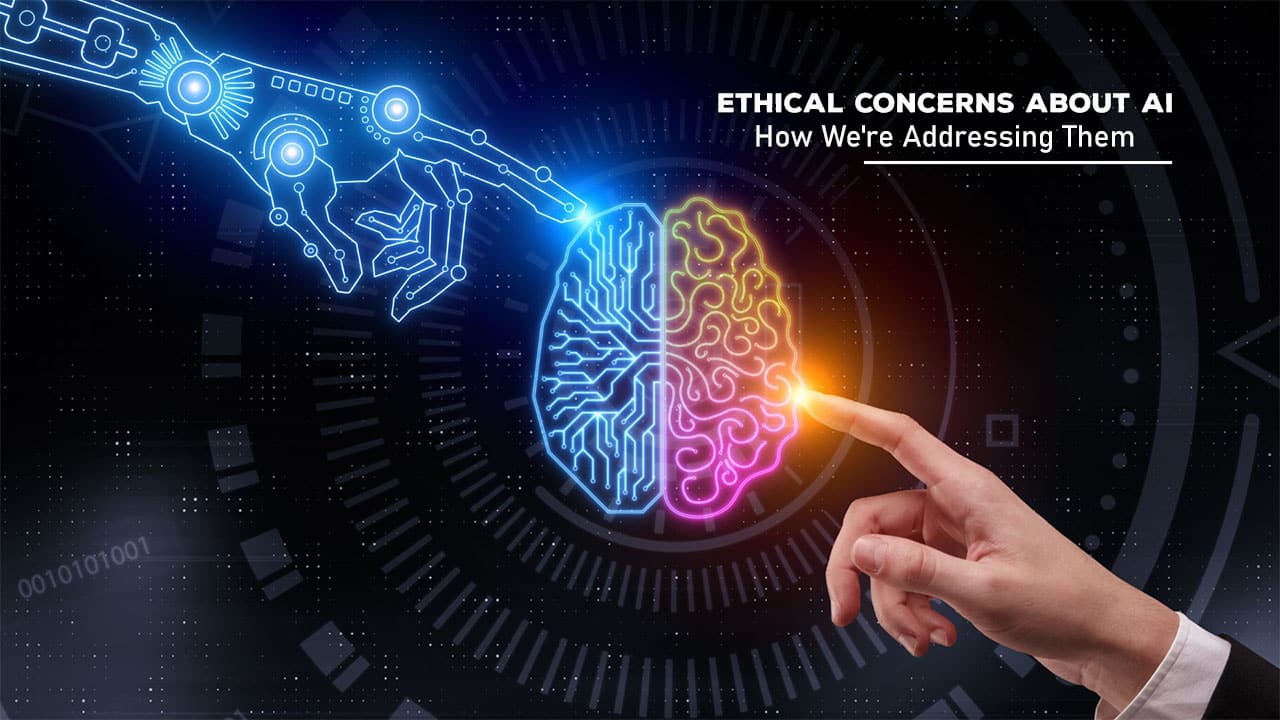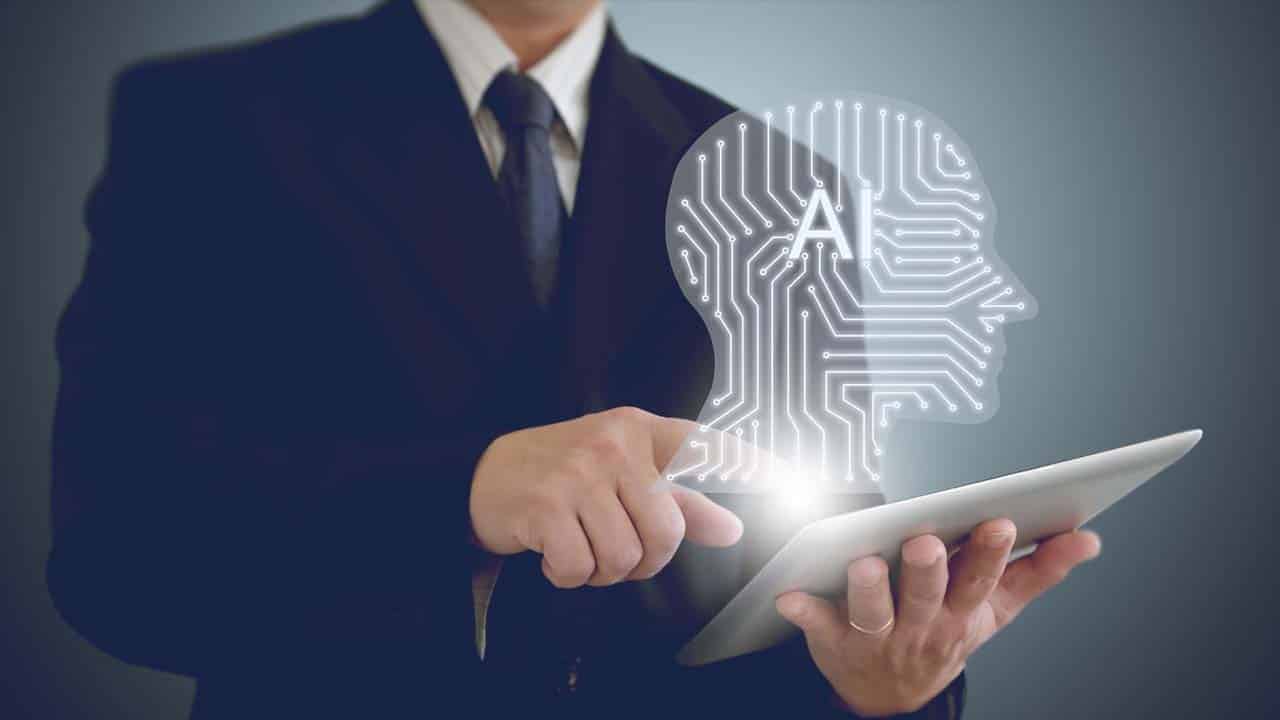AI, a branch of computer science focused on creating intelligent machines that work and react like humans, has made significant strides in recent years. From voice assistants on our smartphones to complex algorithms predicting financial markets, AI is increasingly integrated into our daily lives. However, this rapid advancement raises important questions about privacy, fairness, accountability, and the future of humanity itself.
In this article, we’ll delve into 10 key ethical concerns surrounding AI. We’ll explore the nuances of each issue and discuss the multifaceted approaches being taken by researchers, policymakers, and industry leaders to ensure that AI development aligns with human values and societal well-being.
Ethical Concerns About AI and How We’re Addressing Them
Artificial Intelligence (AI) is revolutionizing our world, offering solutions in fields ranging from healthcare to transportation. However, as AI systems become more sophisticated and ubiquitous, they bring forth a host of ethical challenges. This article examines 10 critical ethical concerns surrounding AI and explores the ongoing efforts to address them.
1. Privacy and Data Protection
AI systems require vast amounts of data to function effectively, often including sensitive personal information. This data hunger raises significant privacy concerns. For instance, AI-powered facial recognition systems used in public spaces can track individuals without their consent. Similarly, AI algorithms analyzing social media data can infer highly personal information, such as political views or sexual orientation, even if users haven’t explicitly shared this information.
The potential for data breaches is another critical issue. In 2019, a data breach at a major biometrics company exposed 28 million records, including fingerprint and facial recognition data. Such incidents highlight the vulnerability of personal data collected for AI systems.
Current Solutions and Strategies
To address these concerns, several approaches are being implemented:
- Legislative measures like the General Data Protection Regulation (GDPR) in Europe and the California Consumer Privacy Act (CCPA) in the United States are setting new standards for data protection.
- Technological solutions such as differential privacy are being developed. This technique adds carefully calibrated noise to datasets, allowing AI to learn from the data without exposing individual records.
- Federated learning is gaining traction as a privacy-preserving machine learning technique. It allows AI models to be trained across multiple decentralized devices holding local data samples, without exchanging them.
2. Bias and Discrimination
AI systems can perpetuate and even amplify existing societal biases, leading to discriminatory outcomes. This issue stems from biased training data and the lack of diversity in AI development teams.
A stark example of this occurred in 2015 when Google’s image recognition algorithm mislabeled photos of Black people as gorillas. In the realm of criminal justice, ProPublica’s 2016 investigation revealed that COMPAS, an AI system used to predict recidivism rates, was biased against Black defendants.
In hiring, Amazon had to scrap an AI recruiting tool that showed bias against women. The system, trained on resumes submitted over a 10-year period, most of which came from men, learned to penalize resumes that included the word “women’s” or mentioned all-women’s colleges.
Tackling the Challenge
Efforts to combat AI bias include:
- Development of bias detection tools: IBM’s AI Fairness 360 toolkit and Google’s What-If Tool help developers test for and mitigate bias in their AI models.
- Promoting diversity in AI development: Initiatives like AI4ALL are working to increase diversity in the AI field, ensuring a wider range of perspectives in AI development.
- Regulatory measures: The Algorithmic Accountability Act, proposed in the U.S. in 2019, would require companies to assess their AI systems for bias and discrimination.
3. Job Displacement
The World Economic Forum predicts that by 2025, 85 million jobs may be displaced by a shift in the division of labor between humans and machines. While AI is expected to create 97 million new jobs, there’s concern about the nature of this transition and its impact on workers.
Certain sectors are particularly vulnerable. For instance, a 2019 report by the Brookings Institution found that 36 million Americans hold jobs with “high exposure” to automation, meaning at least 70 percent of their tasks could soon be performed by machines.
Proactive Measures
To mitigate the impact of AI-driven job displacement:
- Governments and companies are investing in retraining programs. Amazon’s Upskilling 2025 initiative, for example, is a $700 million program to retrain 100,000 employees for in-demand jobs.
- Some regions are experimenting with universal basic income (UBI). Finland’s 2017-2018 UBI trial, while limited, provided valuable insights into how such programs might work.
- There’s a growing focus on developing AI that augments human capabilities rather than replaces them entirely. This “collaborative AI” approach aims to create new types of jobs that leverage the strengths of both humans and AI.
4. Accountability and Transparency
The “black box” nature of many AI systems makes it difficult to understand how they arrive at their decisions. This lack of transparency becomes particularly problematic when AI is used in high-stakes decisions like medical diagnoses, loan approvals, or criminal sentencing.
For instance, in healthcare, IBM’s Watson for Oncology was found to make “unsafe and incorrect” treatment recommendations, as reported by STAT News in 2018. The system’s training data came primarily from a single hospital, leading to biased and potentially dangerous suggestions.
Promoting Clarity
To address these issues:
- Researchers are developing “explainable AI” (XAI) techniques. For example, DARPA’s XAI program aims to produce more explainable models while maintaining high performance levels.
- Regulatory efforts like the EU’s proposed Artificial Intelligence Act include requirements for high-risk AI systems to be sufficiently transparent and subject to human oversight.
- Companies are establishing AI ethics boards. Google’s short-lived Advanced Technology External Advisory Council and Microsoft’s Office of Responsible AI are examples of attempts to provide oversight and guidance on AI development.
5. Autonomous Weapons
The prospect of AI-powered autonomous weapons systems (AWS) that can select and engage targets without meaningful human control raises serious ethical and security concerns. The potential for AWS to lower the threshold for armed conflict, scalable mass atrocities, and unpredictable interactions leading to conflict escalation are among the key issues.
A 2019 report by PAX identified 30 countries currently developing AWS capabilities. The U.S. military’s Project Maven, which uses AI to interpret video images and could be used to improve the targeting of drone strikes, has been particularly controversial.
Preventive Actions
Efforts to address the ethical challenges posed by autonomous weapons include:
- Calls for an international ban: The Campaign to Stop Killer Robots, a coalition of NGOs, is advocating for a preemptive ban on fully autonomous weapons.
- International discussions: The UN Convention on Certain Conventional Weapons (CCW) has been discussing potential limitations on AWS since 2014.
- Ethical stands by researchers: In 2018, over 4,500 AI researchers signed a pledge promising not to participate in the development of lethal autonomous weapons.
6. Misinformation and Deep Fakes
AI-powered tools for creating hyper-realistic fake videos and audio (deep fakes) pose a significant threat to truth and public trust. In 2019, a deep fake video of Facebook CEO Mark Zuckerberg circulated on Instagram, showcasing the potential for such technology to spread misinformation.
The potential for political manipulation is particularly concerning. In 2018, researchers at the University of Washington created a fake video of former President Obama, demonstrating how this technology could be used to fabricate statements from political leaders.
Combating Falsehoods
To counter the threat of AI-generated misinformation:
- Tech companies are developing detection tools. Facebook, Google, and Microsoft are investing in technologies to identify deep fakes.
- Media literacy initiatives are being launched. The News Literacy Project, for instance, is working to educate the public on how to spot fake news and deep fakes.
- Legal measures are being considered. In the U.S., the Malicious Deep Fake Prohibition Act of 2018 was introduced to criminalize the creation and distribution of deep fakes.
7. AI Safety and Control
As AI systems become more complex and autonomous, ensuring they remain safe and controllable becomes increasingly challenging. The concept of an “intelligence explosion” leading to superintelligent AI that could potentially pose existential risks to humanity, while speculative, is taken seriously by many researchers.
More immediate concerns involve AI systems making unexpected and potentially harmful decisions. For example, in 2016, Microsoft’s Twitter chatbot “Tay” began posting offensive tweets within hours of its launch due to interactions with users.
Ensuring Safe Development
Approaches to AI safety include:
- AI alignment research: Organizations like the Machine Intelligence Research Institute are working on ways to ensure advanced AI systems behave in alignment with human values.
- Development of AI “kill switches”: DeepMind, for instance, has researched the implementation of interruption systems that allow human operators to safely stop an AI system.
- Ethical frameworks: The IEEE Global Initiative on Ethics of Autonomous and Intelligent Systems is developing standards for ethically aligned design of AI systems.
8. Privacy in Public Spaces
The proliferation of AI-powered surveillance systems in public spaces raises significant privacy concerns. China’s extensive use of facial recognition technology for public surveillance has drawn international criticism. In the U.S., the use of facial recognition by law enforcement has been controversial, with some cities like San Francisco banning its use.
A 2019 study by the AI Now Institute highlighted how AI-powered affect recognition technology, which claims to infer emotions from facial expressions, is being used in hiring processes and student monitoring, despite lacking a scientific basis.
Protecting Public Privacy
Efforts to address these concerns include:
- Legislative action: The Facial Recognition and Biometric Technology Moratorium Act, introduced in the U.S. Congress in 2020, aims to prohibit federal use of facial recognition technology.
- Development of privacy-preserving technologies: Researchers are working on computer vision techniques that can perform necessary tasks without identifying individuals.
- Public pushback: Growing awareness has led to successful campaigns against the deployment of facial recognition in some areas, such as in schools in New York State.
9. Mental Health and AI Addiction
The addictive nature of AI-driven technologies, particularly social media algorithms designed to maximize user engagement, is raising concerns about mental health impacts. A 2019 study published in JAMA Psychiatry found a significant association between time spent on social media and increased depression and anxiety symptoms among young adults.
The issue extends to AI-powered games and virtual assistants. In China, concerns about gaming addiction led to regulations limiting online game time for minors.
Promoting Digital Wellbeing
Strategies to address these issues include:
- Design changes: Some tech companies are implementing features to help users manage their screen time. Apple’s Screen Time and Google’s Digital Wellbeing are examples.
- Research initiatives: The Digital Wellness Lab at Boston Children’s Hospital is conducting research on the impact of digital technology on mental health and developing guidelines for healthy technology use.
- Regulatory approaches: Some countries are considering legislation to protect children from addictive design features in digital products. The UK’s Age Appropriate Design Code is one such example.
10. Long-term Existential Risk
While more speculative than immediate concerns, the potential long-term risks posed by advanced AI systems are taken seriously by many researchers. The concept of an “intelligence explosion” leading to superintelligent AI that could potentially pose existential risks to humanity is a topic of ongoing debate and research.
Physicist Stephen Hawking, Tesla CEO Elon Musk, and many AI researchers have expressed concerns about the potential for advanced AI to pose existential risks if not properly managed.
Planning for the Future
Efforts to address long-term AI risks include:
- Research institutions: Organizations like the Future of Humanity Institute at Oxford University and the Center for Human-Compatible AI at UC Berkeley are dedicated to studying long-term AI safety.
- AI governance initiatives: The development of global governance frameworks for AI is being discussed in forums like the OECD’s AI Policy Observatory.
- Value alignment research: Projects like the Future of Life Institute’s AI alignment grants are supporting research into ensuring advanced AI systems remain beneficial to humanity.
Takeaways
The ethical challenges posed by AI are complex and multifaceted, requiring ongoing attention and collaborative efforts from researchers, policymakers, industry leaders, and the public. While significant progress is being made in addressing these concerns, the rapid pace of AI development means that ethical considerations must remain at the forefront of AI research and implementation.
As we continue to navigate the ethical landscape of AI, it’s crucial to foster open dialogue, promote interdisciplinary collaboration, and ensure that the development of AI technology is guided by human values and societal well-being. By addressing these ethical concerns proactively, we can work towards a future where AI enhances human capabilities and improves lives while respecting individual rights and societal norms.













































